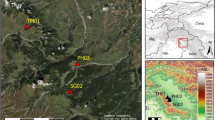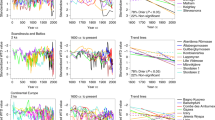Abstract
The processes that build and shape mountain landscapes expose important mineral resources. Mountain landscapes are widely thought to result from the interaction between tectonic uplift and exhumation by erosion1. Both climate and tectonics affect rates of exhumation, but estimates of their relative importance vary2,3. Porphyry copper deposits are emplaced at a depth of about 2 km in convergent tectonic settings; their exposure at the surface therefore can be used to track landscape exhumation. Here we analyse the distribution, ages and spatial density of exposed Cenozoic porphyry copper deposits using a global data set4 to quantify exhumation. We find that the deposits exhibit young ages and are sparsely distributed—both consistent with rapid exhumation—in regions with high precipitation, and deposits are older and more abundant in dry regions. This suggests that climate is driving erosion and mineral exposure in deposit-bearing mountain landscapes. Our findings show that the emplacement ages of porphyry copper deposits provide a means to estimate long-term exhumation rates in active orogens, and we conclude that climate-driven exhumation influences the age and abundance of exposed porphyry copper deposits around the world.
This is a preview of subscription content, access via your institution
Access options
Subscribe to this journal
Receive 12 print issues and online access
$259.00 per year
only $21.58 per issue
Buy this article
- Purchase on Springer Link
- Instant access to full article PDF
Prices may be subject to local taxes which are calculated during checkout




Similar content being viewed by others
References
Whipple, K. X. The influence of climate on the tectonic evolution of mountain belts. Nature Geosci. 2, 97–104 (2009).
Willenbring, J. K. & von Blanckenburg, F. Long-term stability of global erosion rates and weathering during late-Cenozoic cooling. Nature 465, 211–214 (2010).
Herman, F. et al. Worldwide acceleration of mountain erosion under a cooling climate. Nature 504, 423–426 (2013).
Singer, D. A., Berger, V. I. & Moring, B. C. Porphyry Copper Deposits of the 40 World: Database and Grade and Tonnage Models, 2008 Report No. 2008–1155 (US Geological Survey, 2008)
Hoorn, C. et al. Amazonia through time: Andean uplift, climate change, landscape evolution, and biodiversity. Science 330, 927–931 (2010).
Maher, K. & Chamberlain, C. P. Hydrologic regulation of chemical weathering and the geologic carbon cycle. Science 343, 1502–1504 (2014).
Ferrier, K. L., Huppert, K. L. & Perron, J. T. Climatic control of bedrock river incision. Nature 496, 206–209 (2013).
Godard, V. et al. Dominance of tectonics over climate in Himalayan denudation. Geology 42, 243–246 (2014).
Bookhagen, B. & Strecker, M. R. Spatiotemporal trends in erosion rates across a pronounced rainfall gradient: Examples from the southern Central Andes. Earth Planet. Sci. Lett. 327–328, 97–110 (2012).
Sillitoe, R. H. Porphyry copper systems. Econ. Geol. 105, 3–41 (2010).
Wilkinson, B. H. & Kesler, S. E. Tectonism and exhumation in convergent margin orogens: Insights from Ore deposits. J. Geol. 115, 611–627 (2007).
McInnes, B. I. et al. Super Porphyry Copper and Gold Deposits: A Global Perspective Vol. 1, 27–42 (PGC Publishing, 2005).
Kesler, S. E. & Wilkinson, B. H. The role of exhumation in the temporal distribution of ore deposits. Econ. Geol. 101, 919–922 (2006).
Braxton, D. P. et al. From crucible to graben in 2.3 Ma: A high-resolution geochronological study of porphyry life cycles, Boyongan–Bayugo copper–gold deposits, Philippines. Geology 40, 471–474 (2012).
Richards, J. P. Tectono-magmatic precursors for porphyry Cu-(Mo–Au) deposit formation. Econ. Geol. 98, 1515–1533 (2003).
Winguth, A., Shellito, C., Shields, C. & Winguth, C. Climate response at the Paleocene–Eocene thermal maximum to greenhouse gas forcing—a model study with CCSM3. J. Clim. 23, 2562–2584 (2010).
Braconnot, P. et al. Results of PMIP2 coupled simulations of the Mid-Holocene and Last Glacial Maximum; Part 1, experiments and large-scale features. Clim. Past 3, 261–277 (2007).
Finnegan, N. J., Schumer, R. & Finnegan, S. A signature of transience in bedrock river incision rates over timescales of 104–107 years. Nature 505, 391–394 (2014).
Seedorff, E. et al. Porphyry deposits: Characteristics and origin of hypogene features. Econ. Geol. 29, 251–298 (2005).
Hedenquist, J. W. & Taran, Y. A. Modeling the formation of advanced argillic lithocaps: Volcanic vapor condensation above porphyry intrusions. Econ. Geol. 108, 1523–1540 (2013).
Roe, G. H. Orographic precipitation. Annu. Rev. Earth Planet. Sci. 33, 645–671 (2005).
Coates, A. G., Collins, L. S., Aubry, M-P. & Berggren, W. A. The geology of the Darien, Panama, and the late Miocene–Pliocene collision of the Panama arc with northwestern South America. Geol. Soc. Am. Bull. 116, 1327–1344 (2004).
Gordon, R. G. & Jurdy, D. M. Cenozoic global plate motions. J. Geophys. Res. 91, 12389–12406 (1986).
Jeffery, M. L., Poulsen, C. J. & Ehlers, T. A. Impacts of Cenozoic global cooling, surface uplift, and an inland seaway on South American paleoclimate and precipitation δ18O. Geol. Soc. Am. Bull. 124, 335–351 (2012).
Dunai, T. J., López, G. A. G. & Juez-Larré, J. Oligocene–Miocene age of aridity in the Atacama Desert revealed by exposure dating of erosion-sensitive landforms. Geology 33, 321–324 (2005).
Garver, J. I., Reiners, P. W., Walker, L. J., Ramage, J. M. & Perry, S. E. Implications for timing of Andean uplift from thermal resetting of radiation—damaged zircon in the Cordillera Huayhuash, northern Peru. J. Geol. 113, 117–138 (2005).
Kesler, S. E. & Wilkinson, B. H. Earth’s copper resources estimated from tectonic diffusion of porphyry copper deposits. Geology 36, 255–258 (2008).
New, M., Hulme, M. & Jones, P. Representing twentieth-century space–time climate variability. Part II: Development of 1901–96 monthly grids of terrestrial surface climate. J. Clim. 13, 2217–2238 (2000).
Montgomery, D. R. & Brandon, M. T. Topographic controls on erosion rates in tectonically active mountain ranges. Earth Planet. Sci. Lett. 201, 481–489 (2002).
Farr, T. G. et al. The Shuttle Radar Topography Mission. Rev. Geophys. 45, RG2004 (2007).
Acknowledgements
Discussions with B. Wilkinson helped develop the early ideas that led to the research presented in this paper. Reviews by K. Ferrier and D. Cooke greatly improved the manuscript. B.J.Y. was supported by NSF EAR-1251377.
Author information
Authors and Affiliations
Contributions
B.J.Y. and S.E.K. both contributed to the design of the study and analysed the data. B.J.Y. wrote the manuscript. S.E.K. provided input on the manuscript.
Corresponding author
Ethics declarations
Competing interests
The authors declare no competing financial interests.
Supplementary information
Supplementary Information
Supplementary Information (PDF 581 kb)
Supplementary Information
Supplementary Movie (XLSX 77 kb)
Supplementary Movie
Supplementary Movie (MOV 854 kb)
Supplementary Movie
Supplementary Movie (MOV 844 kb)
Rights and permissions
About this article
Cite this article
Yanites, B., Kesler, S. A climate signal in exhumation patterns revealed by porphyry copper deposits. Nature Geosci 8, 462–465 (2015). https://doi.org/10.1038/ngeo2429
Received:
Accepted:
Published:
Issue Date:
DOI: https://doi.org/10.1038/ngeo2429
This article is cited by
-
Tectonic Diffusion Estimates of Global Porphyry Molybdenum Resources
Natural Resources Research (2022)
-
Tempo of magma degassing and the genesis of porphyry copper deposits
Scientific Reports (2017)
-
Rain revs the crustal conveyor
Nature Geoscience (2015)



